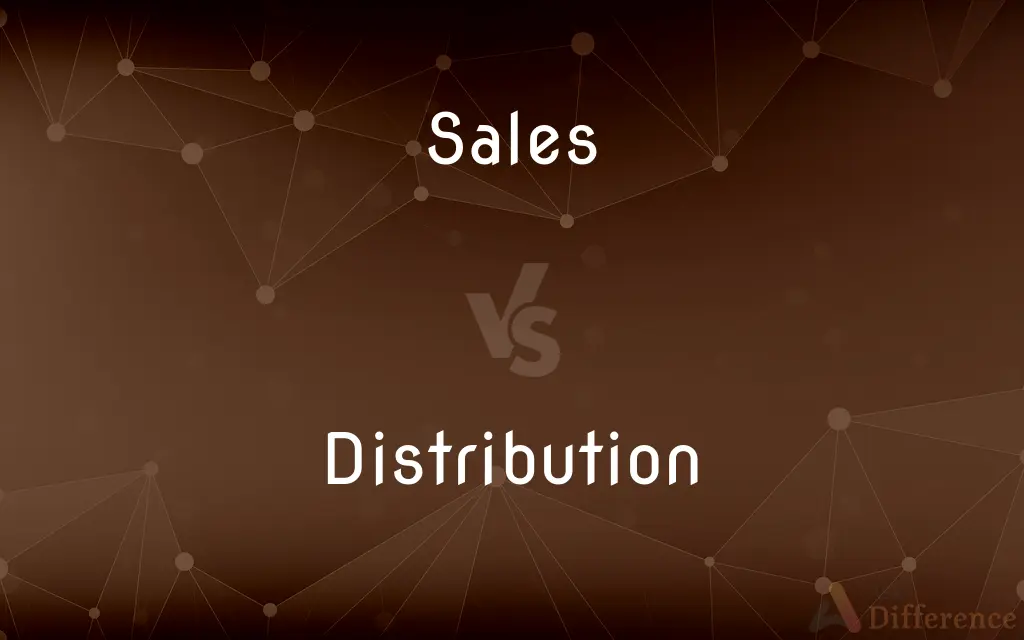Sales vs. Distribution — What's the Difference?
By Urooj Arif & Maham Liaqat — Updated on March 12, 2024
Sales involve the transaction and exchange of goods or services for payment, focusing on customer interaction and revenue generation. Distribution concerns the logistical process of getting the product from the manufacturer to the point of sale.

Difference Between Sales and Distribution
Table of Contents
ADVERTISEMENT
Key Differences
Sales is a key business function that encompasses activities related to the selling of products or services, directly engaging with customers to understand their needs, presenting solutions, and closing deals to generate revenue. On the other hand, distribution is the behind-the-scenes process that ensures the availability of products in various locations where consumers can purchase them. This includes managing relationships with distributors, wholesalers, and retailers, as well as overseeing the logistics of transportation, warehousing, and inventory management.
Sales teams focus on understanding market trends, customer preferences, and competitive dynamics to effectively pitch products or services. They are directly responsible for revenue generation and often work on commission, incentivizing higher sales volumes. In contrast, distribution involves strategic planning to maximize product availability and efficiency in reaching the end consumer. This may include selecting optimal distribution channels, negotiating with third-party logistics providers, and implementing technology to track and manage inventory levels.
Effective sales practices rely on persuasive communication, relationship building, and a deep understanding of the product or service being offered. Successful salespersons possess strong interpersonal skills, adaptability, and the ability to close deals. Distribution, however, requires a more analytical approach, focusing on supply chain optimization, cost reduction, and ensuring timely delivery of products to meet consumer demand.
The relationship between sales and distribution is symbiotic; efficient distribution networks support sales efforts by ensuring that products are available where and when customers want to buy them. Conversely, insights from the sales team can inform distribution strategies, helping to anticipate demand spikes, identify popular products, and optimize inventory levels accordingly.
Both sales and distribution are crucial for the success of a business, but they operate in different spheres. Sales is outward-facing, engaging directly with the customer, while distribution works behind the scenes to streamline the path that products take from production to purchase.
ADVERTISEMENT
Comparison Chart
Focus
Direct customer engagement and revenue generation
Logistics of moving products from manufacturer to market
Key Activities
Customer interaction, deal closing, market analysis
Warehousing, transportation, inventory management
Skills Required
Persuasion, communication, relationship building
Analytical, strategic planning, supply chain management
Objective
Generate revenue through product/service sales
Ensure product availability and efficient market reach
Interaction
Direct with customers
With distributors, wholesalers, retailers
Compare with Definitions
Sales
Requires strong interpersonal skills.
The salesperson's excellent communication skills were key to securing the deal.
Distribution
Process of making products available to consumers.
Efficient distribution networks ensure timely delivery to various sales channels.
Sales
Process of exchanging goods or services for money.
The sales team exceeded their quarterly targets by closing key accounts.
Distribution
Involves logistics, transportation, and warehousing.
The company invested in advanced warehousing solutions to streamline distribution.
Sales
Revenue generation is the primary goal.
Innovative sales promotions led to a significant increase in revenue.
Distribution
Focuses on supply chain optimization.
Strategic distribution planning reduced overall shipping costs.
Sales
Market and product knowledge are crucial.
Keeping up-to-date with market trends allows sales teams to stay competitive.
Distribution
Requires analytical and planning skills.
Distribution managers use data analytics to forecast demand and manage inventory.
Sales
Involves direct interaction with customers.
Effective sales strategies focus on understanding and meeting customer needs.
Distribution
Works with intermediaries like wholesalers and retailers.
Building strong relationships with retailers is vital for effective distribution.
Sales
Sales are activities related to selling or the number of goods sold in a given targeted time period. The delivery of a service for a cost is also considered a sale.
Distribution
The process of marketing and supplying goods, especially to retailers.
Sales
The exchange of goods or services for an amount of money or its equivalent; the act of selling
The sale of such a nice house should be easy.
Distribution
(Law) The transmission of inherited property to its heirs after taxes, debts, and costs of the estate have been paid.
Sales
A selling of property to the highest bidder; an auction.
Distribution
Something distributed; an allotment
Distributions from a retirement account.
Sales
An offer or arrangement in which goods are sold at a discount
The store has a sale on winter coats.
Distribution
The geographic occurrence or range of an organism.
Sales
The business or activity of selling goods or services
She works in sales.
Distribution
The geographic occurrence or range of a custom, usage, or other feature.
Sales
The number of items sold or the amount of money received for a number of items sold
Sales are better than expected.
Distribution
(Statistics) A characterization of the occurrence of the actual unique values in a set of data (as in a frequency distribution) or of the theoretical unique values of a random variable (as in a probability distribution).
Sales
Plural of sale
Distribution
(Mathematics) A generalized function used in the study of partial differential equations.
Sales
The activities involved in selling goods or services.
He's likable and motivated: perfect for a career in sales.
We have a sales training program beginning this Monday.
Distribution
An act of distributing or state of being distributed.
Sales
The amount or value of goods and services sold.
Sales were up 12% over last year.
Distribution
An apportionment by law (of funds, property).
Sales
Income (at invoice values) received for goods and services over some given period of time
Distribution
The process by which goods get to final consumers over a geographical market, including storing, selling, shipping and advertising.
Distribution
Anything distributed; portion; share.
Distribution
The result of distributing; arrangement.
Distribution
The total number of something sold or delivered to the clients.
The distribution of my little rock magazine is about 3,000.
Distribution
The frequency of occurrence or extent of existence.
Distribution
(economics) The apportionment of income or wealth in a population.
The wealth distribution became extremely skewed in the kleptocracy.
Distribution
(card games) The way in which a player's hand is divided in suits, or in which a particular suit is divided between the players.
The declarer had 3-6-2-2 distribution.
Distribution
A probability distribution; the set of relative likelihoods that a variable will have a value in a given interval. Category:en:Functions
Distribution
A subset of the tangent bundle of a manifold that satisfies certain properties; used to construct the notions of integrability and foliation of a manifold.
Distribution
(software) A set of bundled software components
A Linux distribution
Distribution
(finance) The process or result of the sale of securities, especially their placement among investors with long-term investment strategies.
Distribution
(logic) The resolution of a whole into its parts.
Distribution
The process of sorting the types and placing them in their proper boxes in the cases.
Distribution
(steam engines) The steps or operations by which steam is supplied to and withdrawn from the cylinder at each stroke of the piston: admission, suppression or cutting off, release or exhaust, and compression of exhaust steam prior to the next admission.
Distribution
(rhetoric) A rhetorical technique in which a subject is divided into multiple cases based on some property or properties, and each case is addressed individually.
Distribution
The act of distributing or dispensing; the act of dividing or apportioning among several or many; apportionment; as, the distribution of an estate among heirs or children.
The phenomena of geological distribution are exactly analogous to those of geography.
Distribution
Separation into parts or classes; arrangement of anything into parts; disposition; classification.
Distribution
That which is distributed.
Distribution
A resolving a whole into its parts.
Distribution
The sorting of types and placing them in their proper boxes in the cases.
Distribution
The steps or operations by which steam is supplied to and withdrawn from the cylinder at each stroke of the piston; viz., admission, suppression or cutting off, release or exhaust, and compression of exhaust steam prior to the next admission.
Distribution
(statistics) an arrangement of values of a variable showing their observed or theoretical frequency of occurrence
Distribution
The spatial property of being scattered about over an area or volume
Distribution
The act of distributing or spreading or apportioning
Distribution
The commercial activity of transporting and selling goods from a producer to a consumer
Common Curiosities
Can a company handle both sales and distribution?
Yes, many companies manage both sales and distribution internally, although some may outsource distribution to specialized firms.
Is distribution more important than sales?
Neither is more important; both are essential for business success, with sales generating revenue and distribution ensuring product availability.
Can poor distribution affect sales?
Yes, inefficient distribution can lead to stockouts, delayed deliveries, and ultimately dissatisfied customers, negatively impacting sales.
How do sales strategies impact distribution?
Sales strategies can influence distribution by identifying key markets and demand trends, which in turn can optimize inventory and logistics planning.
How does technology influence sales and distribution?
Technology plays a critical role in both fields, from CRM systems that enhance sales processes to supply chain management software that optimizes distribution.
What role do distributors play in sales?
Distributors can act as an extension of the sales team, especially in B2B contexts, by promoting and selling products to retailers or end-users.
Are there different distribution strategies for different products?
Yes, distribution strategies can vary widely depending on the product type, target market, and overall business model.
How does online selling affect distribution?
Online selling often requires more direct distribution strategies, such as drop-shipping or direct mail, to fulfill individual orders efficiently.
How can a business improve its distribution strategy?
Improving distribution can involve adopting new technologies, optimizing logistics routes, better inventory management, and strengthening relationships with logistics partners.
How do changes in consumer behavior affect sales and distribution?
Shifts in consumer behavior, such as increased online shopping, can lead to changes in sales approaches and necessitate adjustments in distribution channels and methods.
Share Your Discovery

Previous Comparison
Meetup vs. Meeting
Next Comparison
Wealthy vs. RichAuthor Spotlight
Written by
Urooj ArifUrooj is a skilled content writer at Ask Difference, known for her exceptional ability to simplify complex topics into engaging and informative content. With a passion for research and a flair for clear, concise writing, she consistently delivers articles that resonate with our diverse audience.
Co-written by
Maham Liaqat













































